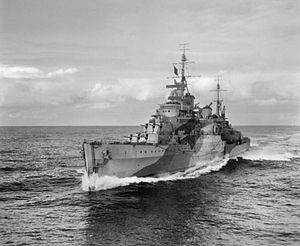 Liverpool in 1942
| |
| Class overview | |
|---|---|
| Name | Town class |
| Operators | |
| Preceded by | Arethusa class |
| Succeeded by | |
| Subclasses |
|
| Built | 1934–1939 |
| In commission | 1937–1963 |
| Completed | 10 |
| Lost | 4 |
| Retired | 5 |
| Preserved | 1 |
| General characteristics | |
| Class and type | Light cruiser |
| Displacement | |
| Length |
|
| Beam |
|
| Draught |
|
| Installed power |
|
| Propulsion | 4 × shafts; 4 × steam turbines |
| Speed | |
| Range | 5,300 nmi (9,800 km; 6,100 mi) at 13 knots (24 km/h; 15 mph) |
| Complement | 750 |
| Armament |
|
| Aircraft carried | 2 × Supermarine Walrus flying boats (removed in the latter part of WWII) |
| Aviation facilities | 1 × catapult |
The Town class consisted of 10 light cruisers built for the Royal Navy during the 1930s. The Towns were designed within the constraints of the London Naval Treaty of 1930. The ships were built in the sub-classes, Southampton, Gloucester and Edinburgh, each sub-class adding more weaponry.